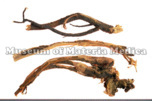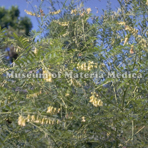Sophora Root

|
Market name:苦参 Photo location:Museum of Materia Medica, Inst. of Nat. Med. TMPW No.:1078 |

|
Plant name:Sophora flavescense Photo location:Kyoto Pref., Japan Photo date:1989 Photographer:K. Komatsu |
| Synonym | |
| Latin name | Sophorae Radix |
| Botanical source: Family name | Leguminosae |
| Botanical source: Plant name | Sophora flavescens Aiton (IPNI:518831-1) |
| Part used | Root |
| Empirical criteria for quality selection | Good one is long and has less twists and turns. The inside is yellowish white in color. It has a strong bitter taste (TN). |
| Constituents | Sterols: β-Sitosterol, Stigmasterol, Campesterol Flavanones & Dihydroflavonols: Kurarinol, Kurarinone, Kuraridinol, Norkurarinol Isoflavones: Trifolirhizin Alkaloids: Matrine, Oxymatrine, Sophoranol, Anagyrine, Methylcytisine, Baptifoline, Sophocarpine, Isomatrine |
| Pharmacological effects | Suppression of the stress ulcer (matrine fraction, oxymatrine fraction). Autokinetic disorder, suppression of the vasomotor center (matrine). Antifungal (decoction: various type of cutaneous Trichophyton). |
| Indications | As an amaroid stomachic, antifebrile, diuretic, antiinflammatory drug, antidiarrheal, for normalizing function of the gall bladder, it is applied to treat skin disease due to blood heat in limbs, stomatitis, bacterial diarrhea, inflammation of the intestines and oliguria. It is used for eczema and parasitic skin disease externally. |
| Diseases | Diarrhea, Hematochezia, Bleeding hemorrhoids, Jaundice, Itching, Leukorrhea, Oliguria |
| Formulas | kujinto , sammotsuogonto , shofusan , jashoshito , tokibaimokujinganryo |
| Meridian tropism | Heart, Liver, Twelve meridians, Large intestine |
| Property | Cold |
| Flavor | Bitter |
| Classification in "Shen-non Ben-cao Jing" | Middle |
| TCM: Classification | Antipyretics (Drugs for elimination heat and dampness) |
| TCM: Medicinal effects | To remove heat and damp, to kill parasites, and to cause diuresis. Used for acute dysentery with bloody stools, jaundice with oliguria, bloody and purulent leukorrhea, pudendal swelling and itching, eczema, sores with exudation, itching of the skin, scabies, and leprosy. External use for trichomonas vaginitis. |
| Remarks | Listed in the Japanese Pharmacopoeia 18th ed. |
| References | TN: T. Namba & Y. Tsuda ed., Outline of Pharmacognosy, a Textbook, 3rd ed., Nankodo Co., Ltd., Tokyo, 1998. |
DNA sequences of medicinal plants
| Gene Region | |||||||||||||||||||
| Nuclear | Chloroplast | Mitochondria | |||||||||||||||||
| Botanical source: Plant name | 5Ss | 18S | ITS1 | 5.8S | ITS2 | 26S | others | trnH-psbA | matK | trnK | trnK-rps16 | trnT-L | trnL | trnL-F | rbcL | rpoC1 | ndhF | others | |
|
|
|||||||||||||||||||
